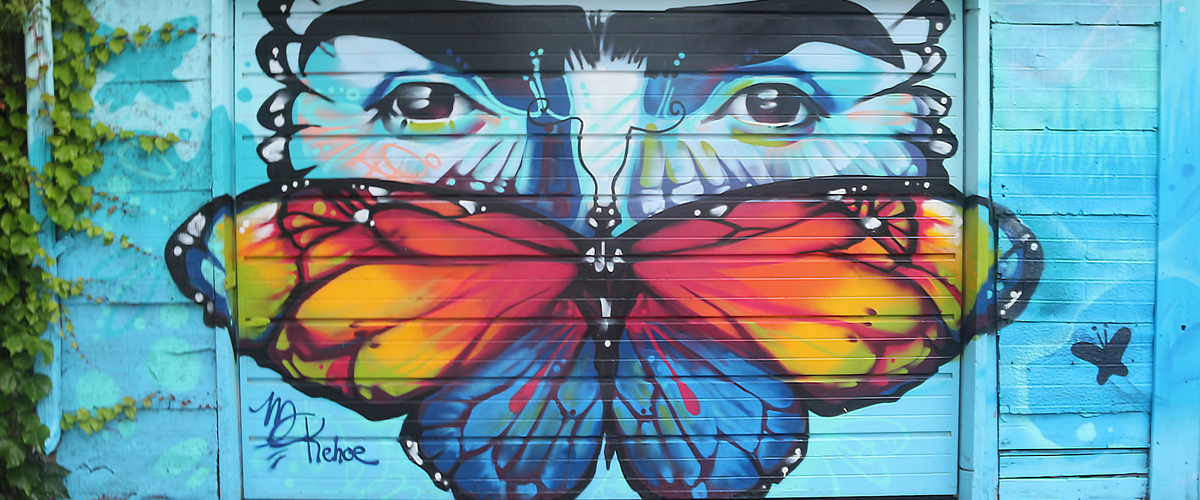Together let’s honour Earth Day by helping out your local pollinators!
By Kimberley Dewing, Comms & Marketing Assistant
*Banner photo from The Butterfly Laneway (along Felstead Park)*
Earth Day is coming up on April 22nd and with the coming spring, and I want to give you some easy, actionable things that you can do to help protect your local pollinators. And in doing so, help combat the climate crisis! While I currently work at East End Arts, I spent the past two years working for a gardening company that specializes in creating and maintaining gardens that support native species, pollinators, stormwater retention, and food production. I’ve learned that there’s a lot of easy, small things that we can do to help support these vital species, and I can’t wait to share some of that knowledge with the EEA community.
When we think of pollinators the first thing that often comes to mind is honey bees and monarch butterflies, but there are plenty of other species working hard to help plants reproduce, fruit, and flourish! Did you know that moths, bats, hummingbirds, beetles and even some species of male mosquitoes count themselves amongst pollinators?
Saving the bees and monitoring monarch butterflies has been a hot issue in the news over the past few years, and we want to keep that buzz going! So, why not take a walk with me down the Butterfly Laneway (Local Discoveries Tour: Danforth Love, Stop #9) and learn a little about what you can do in your community to help moths, bats, beetles and more?!

1. Spring is here and it’s time for garden cleanup!
If you have access to a garden, when the weather starts to warm it’s hard not to want to immediately jump into our flower beds and get to clearing out dead plant matter in preparation for new growth. But, plenty of pollinating insects make their homes in the hollow stems and leaves over the winter. Here’s some tips to consider to make your spring clean up more pollinator-friendly!
- Wait until it’s consistently 10℃ to do your clean up.
- If you absolutely can’t quash the gardening bug:
- Cut and bundle up hollow stem plants and leave them in a quiet corner to give sleepy bees time to wake up.
- Don’t dispose of the dead leaves you clear from your beds, set them aside like the stems until the days have gotten warmer.
- Avoid heavy mulching. Many bees and beetles burrow into the ground to hibernate and a heavy layer of mulch can make it difficult for them to come out when the time comes.

2. Even the tiniest of spaces can make a difference.
The unfortunate reality of living in Toronto is that the majority of us don’t have access to gardens, but a recent study from the University of Sussex has found that even small spaces can make a rich habitat for pollinators!
- A balcony, rooftop, or even windowsill can be more than enough space to plant some native wildflowers.
- Provide passing bees a place to rest by setting up a bee hotel.
- Hummingbird feeders come in all shapes and sizes and some can even be attached to windows.
- On hot days, consider leaving a shallow dish of water out for passing pollinators.

3. Don’t have your own outdoor space? Join or start a community garden.
The city of Toronto has some great initiatives surrounding community gardens! If you don’t have your own space to create pollinator habitat, take a look at what kind of public gardens you may have access to.
- Toronto Urban Growers website has a map of community gardens that you can sort by neighbourhood, as well as other great resources.
- Here’s a short list of some East End community gardens to give you a place to start:
- Railpath Garden (Monarch Park)
- Greenwood Park Community Garden
- Riverdale Meadow Community Garden

4. Learn about local initiatives and educate!
One of the best possible things you can do is to keep on educating yourself about your local pollinators. Do you know what is being done by your city and your province to protect these vital species? Don’t forget to share your knowledge out, as it might inspire others to action! Here’s a few things you may not know about the City of Toronto’s efforts to protect pollinators:
- Toronto has a Pollinator Protection Plan, check out this beautiful PDF to read all about it.
- The PollinateTO Grant is an annual grant for people or organizations who want to start a new pollinator or rain garden.
- Toronto is an official Bee City! Check out the Bee City Canada website to see what being a Bee City is all about.

5. Live humbly, in community, and with reciprocity.
One of the best ways that we can support your local pollinators is to just show up, and be present in the world. Learn the names of your local trees, plants, bees and butterflies.
Our local insects, animals and plants are just as part of our community as our next door neighbour, our favourite local coffee shop, our daycare and our neighbourhood library.
This Earth Day, go for a walk, and notice who calls your neighbourhood home. Take one of East End Arts’ free Local Discoveries public art tours and see what’s growing up around the murals and sculptures. Fall a little in love with your locals! Notice the bunch of asters that come back year after year in the corner of your favourite park, and how much the bees love them. These are the quiet, small things that make the neighbourhoods we love.

